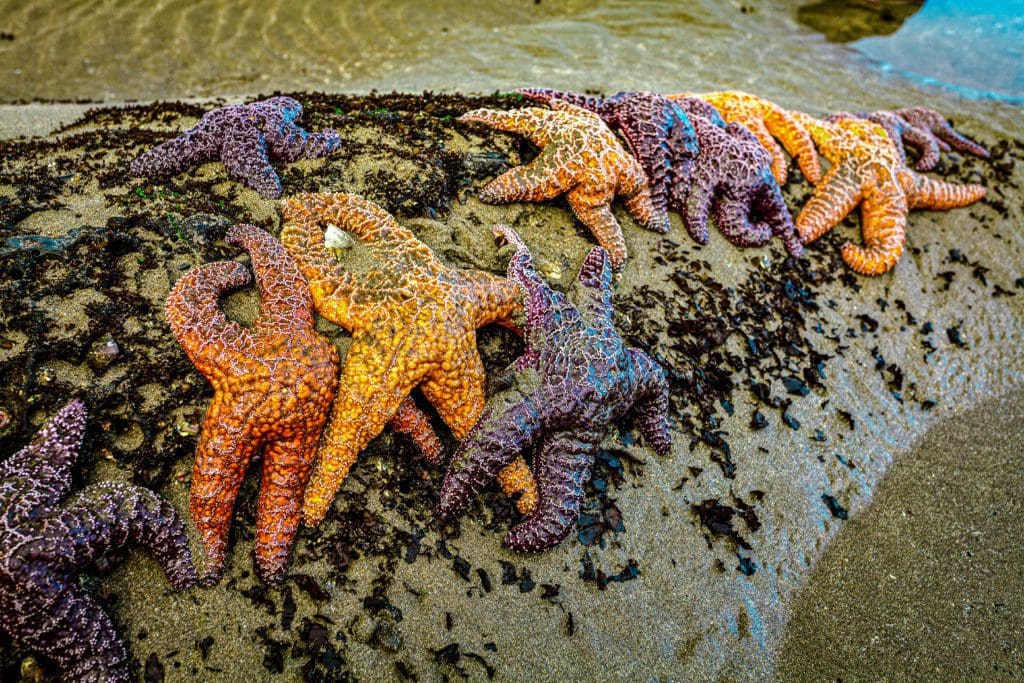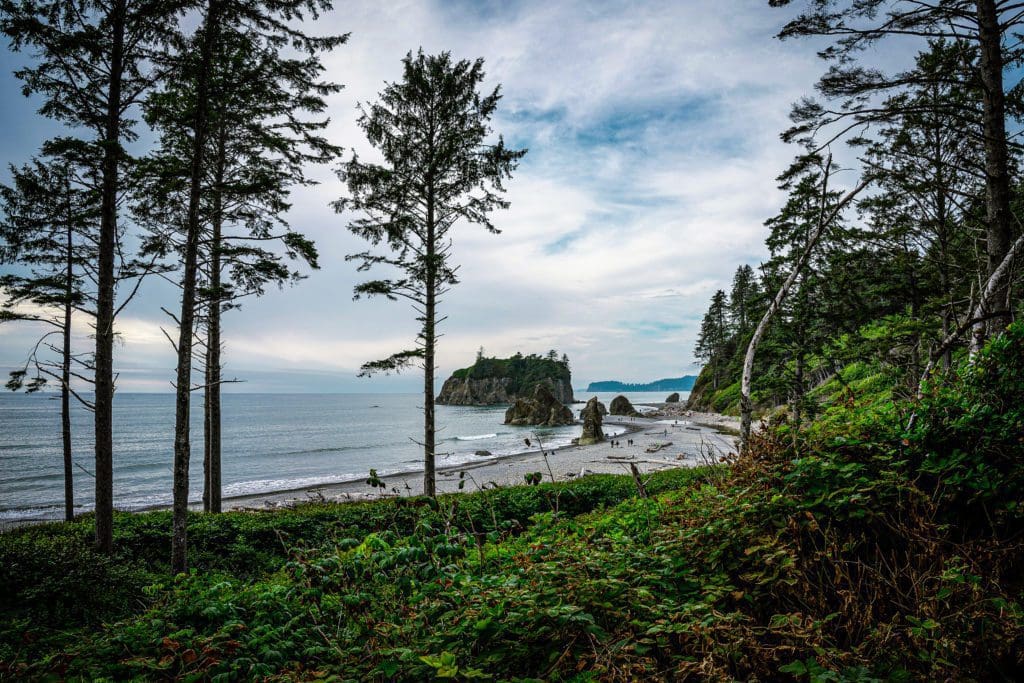|
Getting your Trinity Audio player ready...
|
Explore tide pools in Olympic National Park for a mini-adventure into marine life. The park has diverse pools with colorful creatures, from sea stars and anemones to hermit crabs and fish.
Have you ever thought about what a tide pool is? It’s a section of shoreline left behind when the ocean recedes with the ebb of the tide. These small pools are home to a variety of resilient creatures, ranging from starfish to anemones. Despite their tranquil appearance, they also face constant changes in their environment and potential dangers such as powerful currents and intense sunlight exposure.
Delving into the tide pools of Olympic National Park is a mini-adventure that exposes you to the captivating world of marine life. As you traverse the rocky shores, you’ll encounter an array of colorful creatures that inhabit the diverse range of tide pools along the Pacific Northwest coast.

Sea stars (Pisaster Ochraceus) clustered in a tide pool at low tide.
There is something invigorating about the sun, salty air, and refreshingly cool waters. When many people go to the beach, they let their kids explore freely, which they love. This coastal location allows visitors to see rare ocean phenomena more easily. It can be noted that one can look but don’t touch these delicate creatures.
One of the most enthralling aspects of exploring these tide pools is witnessing how these marine organisms adapt to the ever-changing tides. From brilliantly hued sea stars and anemones to elusive hermit crabs and tiny fish, there’s no shortage of fascinating creatures to discover.
Moreover, besides the mesmerizing marine life, you also get a glimpse into the geological history of this region. The rocky shores boast intricate patterns of erosion and layers of sediment that reveal the ancient past of this area.
Venturing into the tide pools in Olympic National Park promises an unforgettable experience as you immerse yourself in the enthralling world of marine life and unravel the region’s geological history. So pack your curious spirit and sense of adventure, and embark on a journey through the alluring tide pools in Olympic National Park.

Kalaloch Beach 4 is one of Olympic National Park’s best locations for exploring tide pools.
Tide Pool Marine Life
The tide pools in Olympic National Park are a bustling ecosystem filled with diverse marine life. These creatures have evolved to thrive in the constantly changing environment of the tide pools, where they must endure the tides’ constant ebb and flow.
Sea stars, anemones, barnacles, and mussels are among the most common inhabitants of the tide pools. They can often be seen clinging to rocks or other surfaces, filtering out plankton and other organic matter as it drifts by in the water.
But there are also many other fascinating creatures that call Olympic National Park’s tide pools home. From hermit crabs to chitons to various species of fish, these animals have adapted to survive in the harsh conditions of the tide pools, facing challenges such as fluctuating temperature, salinity levels, and oxygen levels.
One of the most captivating aspects of exploring these tide pools is witnessing the remarkable adaptability of these marine organisms. As the tides ebb and flow, these creatures must quickly adjust to the changing conditions in order to survive.

Sea Anemone in tide pool in Olympic National Park.
Most Popular Tidepools
Some of the most visited tidepools in Olympic National Park are located at Kalaloch’s Beach 4 and Mora’s Hole in the Wall. Other popular spots include Second Beach, Third Beach, and Ruby Beach. For details on the best beaches in Olympic, see our guide.
The key to successful tidepooling is timing. Tides at the park change daily, and not all low tides provide the same viewing opportunities. The best time for tidepooling is during a “minus tide”, when the water levels are even lower than usual. Aim for tides that are less than 1 foot for optimal tidepool exploration.
See the tide charts for the entire Pacific Coast: Destruction Island Tides before you visit the beach.

Hole in the wall at Rialto Beach.
Safety in the Tidepools:
- Always keep an eye on the tide and be aware of “sneaker waves” that can quickly return.
- Be cautious when walking on rocks covered in algae and seaweed, as they can be very slippery. Test each rock before putting your full weight on it.
- Wear sturdy shoes that you don’t mind getting wet.
- Keep a close watch on children, as rocks and waves can be unpredictable and lead to serious injuries if not careful.
- Do not bring dogs onto the tidal rocks, as their paws can get cut by sharp stones, barnacles, and mussels which may cause infection.
- Avoid jumping from one rock to another; always have at least one foot firmly on the ground.
Important Safety Precautions for Hole in the Wall:
Avoid crossing through Hole in the Wall when the tide starts to cover the floor of the arch. This area is constantly hit by waves, and rocks can fall at any time, making it dangerous to stay under or next to the arch for long periods of time. If you hear rocks falling, protect your head and move away from the arch.
If you plan on exploring the tidepools at Hole in the Wall alone, make sure to arrive at least 30 minutes before the lowest tide. Keep in mind that it takes a 1.5 mile (1 hour) hike from the parking area at Rialto Beach to reach Hole in the Wall.
Popular Articles:
Adventurer’s Guide To Olympic National Park, Washington.
Essentials For An Autumn Weekend Water Adventure
Guided Backpacking Tours in Olympic National Park
Inspired by Bright Spots in Rough Waters, YETI’s King Crab Collection











